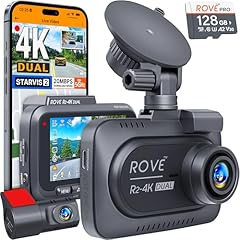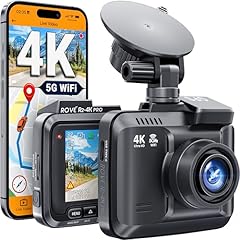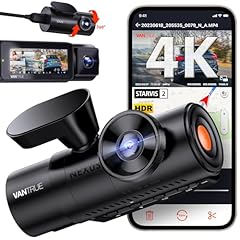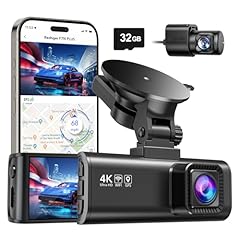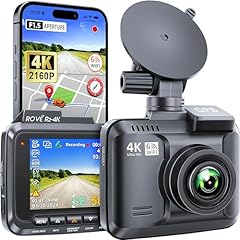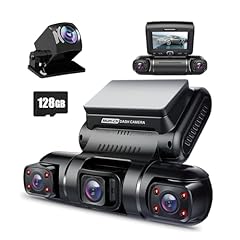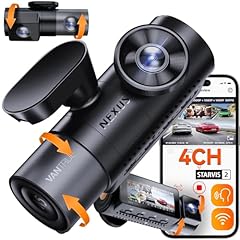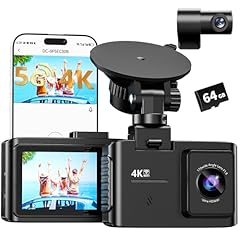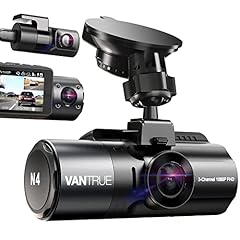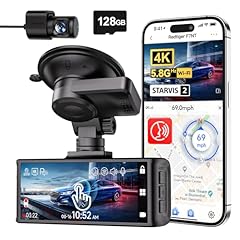-
1
Best Overall Offers 4K Ultra HD front camera recording.
Offers 4K Ultra HD front camera recording. Comes with a 128GB memory card.
Comes with a 128GB memory card. Includes both front and rear cameras.
Includes both front and rear cameras. -
2
 Crisp 4K video quality captures fine details.
Crisp 4K video quality captures fine details. Built-in GPS logs your driving route.
Built-in GPS logs your driving route. 5G WiFi allows quick video transfers.
5G WiFi allows quick video transfers. -
3
 High-quality 4K HDR video recording.
High-quality 4K HDR video recording. Excellent night vision with STARVIS 2 sensor.
Excellent night vision with STARVIS 2 sensor. Supports up to 512GB memory.
Supports up to 512GB memory. -
4
Hot Deal 4K front camera ensures superb video quality.
4K front camera ensures superb video quality. Built-in Wi-Fi and GPS for easy tracking.
Built-in Wi-Fi and GPS for easy tracking. 24-hour parking mode for constant surveillance.
24-hour parking mode for constant surveillance. -
5
Popular High-resolution 4K video captures clear details.
High-resolution 4K video captures clear details. Built-in GPS tracks routes and speed.
Built-in GPS tracks routes and speed. Night vision ensures clear footage in dark conditions.
Night vision ensures clear footage in dark conditions. -
6
 Provides comprehensive 360-degree coverage for complete security.
Provides comprehensive 360-degree coverage for complete security. Built-in GPS and WiFi for easy tracking and sharing.
Built-in GPS and WiFi for easy tracking and sharing. Comes with a free 128G card for ample storage.
Comes with a free 128G card for ample storage. -
7
 360° coverage captures all angles effortlessly.
360° coverage captures all angles effortlessly. STARVIS 2 IR ensures clear night vision.
STARVIS 2 IR ensures clear night vision. Voice control offers hands-free operation.
Voice control offers hands-free operation. -
8
Best Affordable High-resolution 4K video captures clear details.
High-resolution 4K video captures clear details. Dual cameras cover front and rear views.
Dual cameras cover front and rear views. Convenient app control with 5GHz WiFi.
Convenient app control with 5GHz WiFi. -
9
 Triple camera coverage ensures comprehensive recording.
Triple camera coverage ensures comprehensive recording. Excellent night vision with infrared capabilities.
Excellent night vision with infrared capabilities. Supports up to 256GB for extensive storage.
Supports up to 256GB for extensive storage. -
10
 4K resolution offers ultra-clear video quality.
4K resolution offers ultra-clear video quality. Built-in WiFi and GPS for easy connectivity.
Built-in WiFi and GPS for easy connectivity. Night vision ensures clear recordings in low light.
Night vision ensures clear recordings in low light.
Overview of Wireless Dash Cam
Navigating the bustling world of traffic can feel like a wild ride, right? Think of a wireless dash cam as your reliable co-pilot, faithfully recording all the road's unpredictability. In a sea of options, we've pored over the details to bring you the best of these unblinking eyes on the road. Using our sharp, methodical research approach, we've evaluated a host of options, weighing factors like image quality, ease of use, and reliability to separate the truly worthy from the rest. Whether you're a road trip enthusiast capturing scenic drives, a ride-share driver looking for an extra layer of insurance, or just someone who likes to keep tabs on the road's surprises, our top picks below have got you covered. So buckle up, you're about to embark on a journey to find a wireless dash cam that's perfect for your needs.Top Wireless Dash Cam
• ROVE R2-4K Dual Dash Cam with 128GB Card• ROVE R2-4K PRO Dash Cam with GPS and WiFi• Vantrue N4 Pro 3 Channel 4K WiFi Dash CamFAQ
Q: How does a wireless dash cam work?
A: A wireless dash cam records and processes video footage of your driving, storing it on a memory card. The wireless feature means it can transfer the footage directly to your smartphone or tablet through an app, making it easier to access and share your recordings.
Q: What are the benefits of using a wireless dash cam?
A: A wireless dash cam provides numerous benefits, including evidence in case of an accident, monitoring your parked car, and capturing unexpected events on the road. Moreover, the wireless feature allows for easy footage access and transfer, eliminating the need to remove the memory card.
Q: How do I install a wireless dash cam?
A: Installation of a wireless dash cam usually involves affixing the device on your windshield, running the power cable to your car’s 12V power outlet, and setting it up via an app on your smartphone. The app will guide you through the connection process and any necessary settings.
Q: Can a wireless dash cam drain my car battery?
A: A wireless dash cam uses minimal power, so it's unlikely to significantly drain your car battery. However, if your dash cam is running continuously while your car is off, it may cause some battery drain. Many models come with a feature that automatically turns off the dash cam when your battery voltage drops to a certain level.
Q: What should I look for when purchasing a wireless dash cam?
A: When purchasing a wireless dash cam, consider the video quality, ease of installation, the reliability of the wireless connection, and the usability of the accompanying app. Also, check if the dash cam comes with features like parking mode, GPS, and loop recording. It's also beneficial to read customer reviews to get an idea of the product's performance.

